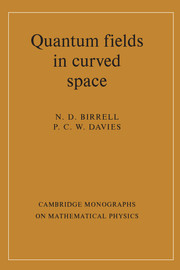Book contents
- Frontmatter
- Contents
- Preface
- Preface to the paperback edition
- Conventions and abbreviations
- 1 Introduction
- 2 Quantum field theory in Minkowski space
- 3 Quantum field theory in curved spacetime
- 4 Flat spacetime examples
- 5 Curved spacetime examples
- 6 Stress-tensor renormalization
- 7 Applications of renormalization techniques
- 8 Quantum black holes
- 9 Interacting fields
- References
- Index
8 - Quantum black holes
Published online by Cambridge University Press: 05 August 2012
- Frontmatter
- Contents
- Preface
- Preface to the paperback edition
- Conventions and abbreviations
- 1 Introduction
- 2 Quantum field theory in Minkowski space
- 3 Quantum field theory in curved spacetime
- 4 Flat spacetime examples
- 5 Curved spacetime examples
- 6 Stress-tensor renormalization
- 7 Applications of renormalization techniques
- 8 Quantum black holes
- 9 Interacting fields
- References
- Index
Summary
In January 1974, Hawking (1974) announced his celebrated result that black holes are not, after all, completely black, but emit radiation with a thermal spectrum due to quantum effects. This announcement proved to be a pivotal event in the development of the theory of quantum fields in curved spacetime, and greatly increased the attention given to this subject by other workers. In devoting an entire chapter to the topic of quantum black holes, we are reflecting the widespread interest in Hawking's remarkable discovery.
With the presentation of all the major aspects of free quantum field theory in curved spacetime complete, we here deploy all the various techniques described in the foregoing chapters. The basic result – that the gravitational disturbance produced by a collapsing star induces the creation of an outgoing thermal flux of radiation – is not hard to reproduce. The wavelength of radiation leaving the surface of a star undergoing gravitational collapse to form a black hole is well known to increase exponentially. It therefore seems plausible that the standard incoming complex exponential field modes should, after passing through the interior of the collapsing star and emerging on the remote side, also be exponentially redshifted. It is then a simple matter to demonstrate that the Bogolubov transformation between these exponentially redshifted modes and standard outgoing complex exponential modes is Planckian in structure. This implies that the ‘in vacuum’ state contains a thermal flux of outgoing particles.
- Type
- Chapter
- Information
- Quantum Fields in Curved Space , pp. 249 - 291Publisher: Cambridge University PressPrint publication year: 1982



